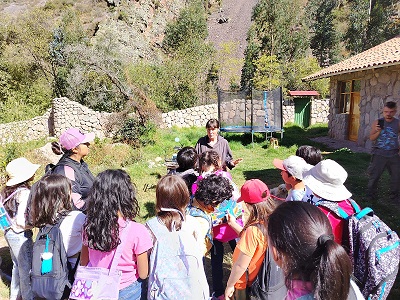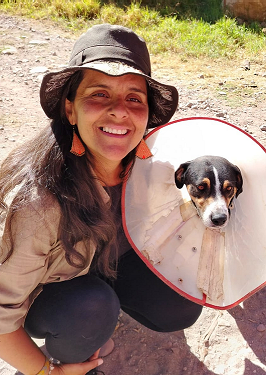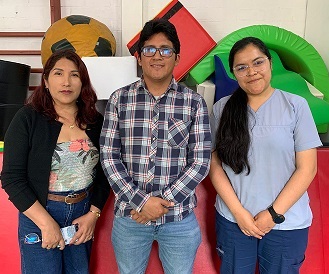Magali Pestana is a teacher at Kuska School in Ollantaytambo, located in the Sacred Valley of the Incas, in Cusco, Peru. In this interview for the 3Love Inc. blog, we talk about a project Magali has been working on with her students about the problem of stray dogs and cats and the impact this has on their community, as well as the importance of raising awareness among them from an early age about the care and protection of animals.
You work at Kuska School in Ollantaytambo. Tell us about the project you have been working on with your students regarding the care of dogs and cats. What does it consist of and what kind of activities have you done?
Thank you for this interview. At Kuska School in the community of Ollantaytambo, every two months we do projects that are related to social and emotional issues, but also deeply rooted in the community where the children live. These last two months we did a project on stray dogs and cats and their impact on the community of Ollantaytambo. We started with guiding questions so that the children could come up with their own. The guiding questions that were formulated were: “Why are some humans disconnected from animals?” and “How can domestic animals survive on the streets without basic care such as food, shelter, and affection?”. From these two questions, we began to branch out into other questions that we started to investigate. As a teacher, I guided them so that we could do things related to legislation and animal rights, not only in Peru but also in other parts of the world, so that they could learn about the differences and what rights and duties we have as citizens for peaceful coexistence. And so, we unraveled everything.
How old are your students? Are they from Ollantaytambo or do they also come from other areas of the Sacred Valley of Cusco?
There are 12 students. They all live in Ollantaytambo and the surrounding area. Some are from Lima and others are from the community of Ollantaytambo, so there is a mix of backgrounds. This is a multi-grade school, with third and fourth grade classes. The students are between 8 and 10 years old.
As part of this project, you visited the Colitas con canas dog shelter in Urubamba. What activities did you do at the shelter, and how did the students react when interacting with older dogs or dogs with disabilities?
When they arrived, the students were very excited; all they wanted to do was see all the dogs. At the beginning, Emily did a great job introducing a disabled dog in a very natural way, and the students saw how happy and comfortable the dog was. She introduced us to all the dogs with disabilities. Some had walkers so they could walk on their hind legs, others also saw how they could relieve themselves because they had no bladder control, but they were all happy, wagging their tails, and the students petted them. Then she introduced us to the dogs that had been sick and had recovered. And we continued to interact with them. I could really see the children’s faces, totally engaged with the dogs, and they said, “Teacher, I want to adopt this one, I’m going to tell my mom.” Then Emily took the opportunity to say, “It’s not that easy to adopt, we have to interview the family.” And then she gave us a talk that focused on what we as citizens can do about this problem. She shared her experience and the children also asked her questions. She gave them a very nice talk that was rooted in a social issue.
Why do you think it is important to raise children’s awareness about caring for and protecting animals from an early age?
I think it’s very important for them to be able to see not only themselves, but also what is happening around them, whether it’s how they relate to other human beings, but also how they relate to their entire environment and other living beings: animals and plants, which are so important for us to survive on the planet. I believe that we help them all the time from the core of the school. Through experience and coexistence, we are constantly learning how to relate to others and, in particular, to domestic animals. Children naturally have empathy, and we could even say that some have more empathy for animals than for other children, because they already have a connection from home, and when they see them outside, they ask themselves important questions: “What’s going on? Why are they outside? Why are they left on the street?” In particular, in the provinces, especially in the Andes, domestic animals do have a use. I think this has been the case for many generations: dogs guard and cats take care of rodents. There are many dogs that you see that have owners, but they stay on the street or at the doors. In other words, the owners don’t necessarily let them in for many hours. We could see many dogs at the doors at night. So, they guard from the street.
This month was Teacher’s Day in Peru. What motivated you to become a teacher?
I studied communications, I am a communicator focused on audiovisual media, and I am a photographer. I have a vocation for observation. I have always had this psychological side to me, that is, observing behavior and the minds of others, and life led me to teach creative workshops. In the summers, I taught workshops for children, but I continued my degree in communications. Then, when I finished my degree, I worked as a photographer, but later I wanted to be a teacher and began studying early childhood education. There, I was taught psychology, which is something I am passionate about. I finished my degree and started working as an early childhood teacher, and then I decided to carry out an educational project. So, I combined communication with education and also focused on the children’s self-esteem through environmental awareness. It was like a project to create vegetable gardens and work on math, communication, and a lot of other things with everything that came from the earth. After that, I focused more on doing workshops and working with older elementary school children. As I said at the beginning, this passion for observation that photography brings me is always reflected in my classes, and I can see and accompany each of the children as a unique person who is in the process of behavioral, emotional, mental, and spiritual development. So, I think that being a companion encompasses all of this.



